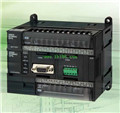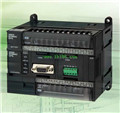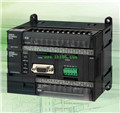Download Sort:
OMRON
CP1L-M30DT-A INSTRUCTIONS REFERENCE MANUAL ()
Product model: CP1L-M30DT-A
Name: PLC
Brand: OMRON
Sort: INSTRUCTIONS REFERENCE MANUAL
File language: English
Download link: OMRON CP1L-M30DT-A INSTRUCTIONS REFERENCE MANUAL
Unit type: CS1 Special I/O Units.
name: Position control unit.
Specifications: Control method/Control,
output interface, Open-loop control by,
pulse train output/Open-collector output;
Number of control axes, 4 axis.
No. of unit numbers allocated: 2.
Current consumption: 5V, 0.36A; 26V, --.
Standards: U, C, N, L, CE CP1L-M30DT-A INSTRUCTIONS REFERENCE MANUAL.
High-speed, High-precision,
positioning with 1, 2, or 4 axes CP1L-M30DT-A
Versatile functions and superb,
performance enable the construction,
of compact, high-performance machines.
With its ultra-compact size of 31×90mm,
(W×H),this highly space-efficient Position,
Control Unit(PCU) enables up to 4 axes,
of motor control.Model: CPM2A-40CDR-A. Power supply: AC power supply CP1L-M30DT-A INSTRUCTIONS REFERENCE MANUAL.
Output type: Relay.
Inputs points: 24 points.
Outputs points: 16 points.I/O bits: 960 (Expan-sion Racks: 2).
Program capacity: 20K steps.
Data memory capacity: 64K words (DM: 32K words, EM: 32K words ×1 bank)Name: MIL Connectors.
Specifications: Inputs;
32 inputs ; PNP; --.
"Easy" and "Flexible" system expansion,
with linked CC-Link and CompoNet.
Branching is easily made with CompoNet CP1L-M30DT-A INSTRUCTIONS REFERENCE MANUAL.
Wiring material cost can be reduced.
Bit-level I/O distribution reduces,
wiring in the system.
A wide variety of CompoNet Slave Units,
contribute to system size reduction.
Seven-segment Display on the Gateway Unit,
helps to detect errors on site.
The Participation Flags and Communications,
Error Flags can be checked at the Host,
Controller to detect the location and,
content of the error. Model : C500-PS212.
Expansion I/O Backplane Power Supply
24 VDC.
Output ratings: 7 A, 5 VDC.Applicable CPU Units: CQM1H-CPU51/61.
Absolute Encoder inputs: 2 inputs.
Dimensions: 25 × 110 × 107 mm (W × H × D).
Weight: 90 g max.
Model: C200H-MD501.
No. of I/O pts: 16 inputs, 16 outputs.
Specifications: 5 VDC.Unit type: 10 I/O points 6 inputs; 4 outputs, Connector.
Input: 6 points: 24 VDC.
Output: 4 points: transistor (sourcing).
Clock: Yes.
Slaves with the Complex Functionality Needed,
for Distributed Blocks.
Programmable Slaves combine devices, such as sensors and actuators,
into one functional unit that is treated as a DeviceNeet slave CP1L-M30DT-A Manual.
Programmable Slaves greatly facilitate device distribution,
and functional organization.
They help standardize programming between units and reduce the amount of,
programming required at the master.
I/O and operatiional checks can be performed for each functional unit,
rather than waiting CP1L-M30DT-A Manual.
for final system assembly, as with conventional distributed I/O systems.
name: Position control unit.
Specifications: Control method/Control,
output interface, Open-loop control by,
pulse train output/Open-collector output;
Number of control axes, 4 axis.
No. of unit numbers allocated: 2.
Current consumption: 5V, 0.36A; 26V, --.
Standards: U, C, N, L, CE CP1L-M30DT-A INSTRUCTIONS REFERENCE MANUAL.
High-speed, High-precision,
positioning with 1, 2, or 4 axes CP1L-M30DT-A
Versatile functions and superb,
performance enable the construction,
of compact, high-performance machines.
With its ultra-compact size of 31×90mm,
(W×H),this highly space-efficient Position,
Control Unit(PCU) enables up to 4 axes,
of motor control.Model: CPM2A-40CDR-A. Power supply: AC power supply CP1L-M30DT-A INSTRUCTIONS REFERENCE MANUAL.
Output type: Relay.
Inputs points: 24 points.
Outputs points: 16 points.I/O bits: 960 (Expan-sion Racks: 2).
Program capacity: 20K steps.
Data memory capacity: 64K words (DM: 32K words, EM: 32K words ×1 bank)Name: MIL Connectors.
Specifications: Inputs;
32 inputs ; PNP; --.
"Easy" and "Flexible" system expansion,
with linked CC-Link and CompoNet.
Branching is easily made with CompoNet CP1L-M30DT-A INSTRUCTIONS REFERENCE MANUAL.
Wiring material cost can be reduced.
Bit-level I/O distribution reduces,
wiring in the system.
A wide variety of CompoNet Slave Units,
contribute to system size reduction.
Seven-segment Display on the Gateway Unit,
helps to detect errors on site.
The Participation Flags and Communications,
Error Flags can be checked at the Host,
Controller to detect the location and,
content of the error. Model : C500-PS212.
Expansion I/O Backplane Power Supply
24 VDC.
Output ratings: 7 A, 5 VDC.Applicable CPU Units: CQM1H-CPU51/61.
Absolute Encoder inputs: 2 inputs.
Dimensions: 25 × 110 × 107 mm (W × H × D).
Weight: 90 g max.
Model: C200H-MD501.
No. of I/O pts: 16 inputs, 16 outputs.
Specifications: 5 VDC.Unit type: 10 I/O points 6 inputs; 4 outputs, Connector.
Input: 6 points: 24 VDC.
Output: 4 points: transistor (sourcing).
Clock: Yes.
Slaves with the Complex Functionality Needed,
for Distributed Blocks.
Programmable Slaves combine devices, such as sensors and actuators,
into one functional unit that is treated as a DeviceNeet slave CP1L-M30DT-A Manual.
Programmable Slaves greatly facilitate device distribution,
and functional organization.
They help standardize programming between units and reduce the amount of,
programming required at the master.
I/O and operatiional checks can be performed for each functional unit,
rather than waiting CP1L-M30DT-A Manual.
for final system assembly, as with conventional distributed I/O systems.
Related products
OMRON
CP1L CPU Unit
CP1L-M30DT-D

CPU Unit: CP1L-M CPU Units with 30 Point
OMRON
CP1E CPU Units
CP1E-N30DT-A

Product name: N-type CPU Units with 30
OMRON
CP1L CPU Unit
CP1L-M40DR-A

CPU Unit: CP1L-M CPU Units with 40 Point
OMRON
CP1L CPU Unit
CP1L-M60DT-D

CPU Unit: CP1L-M CPU Units with 60 Point
